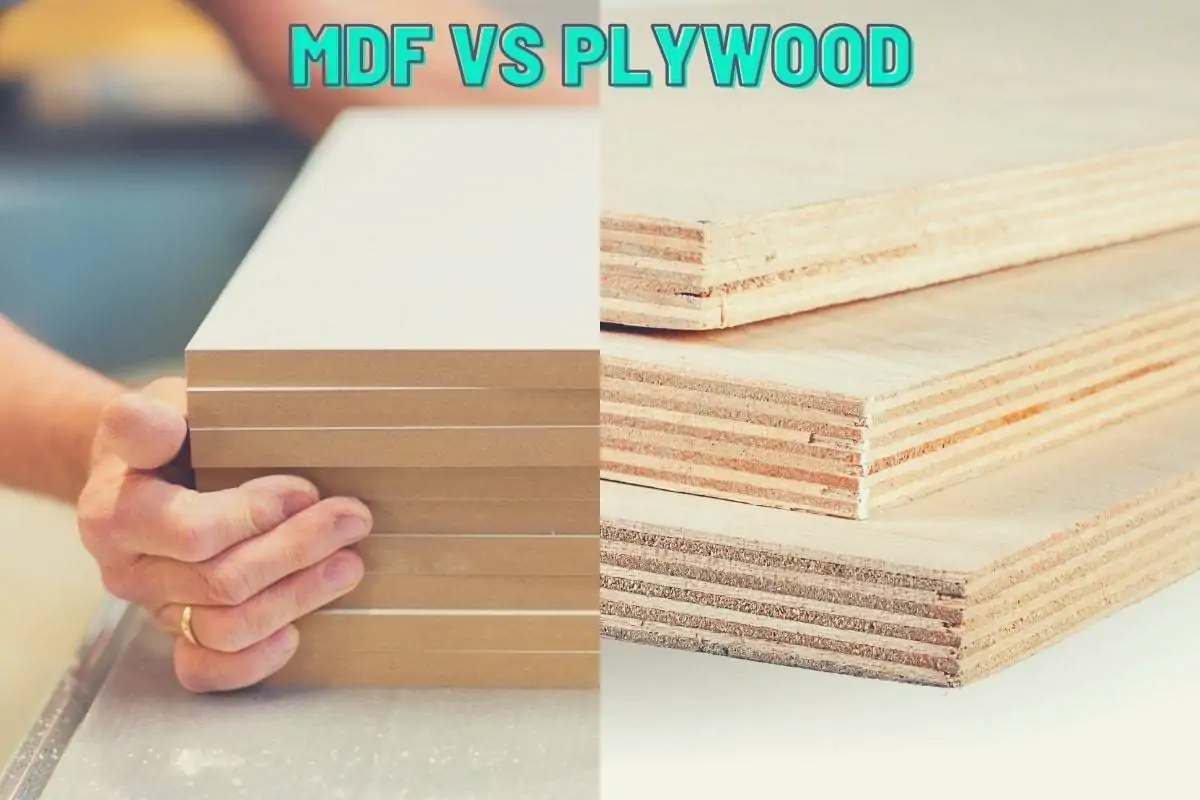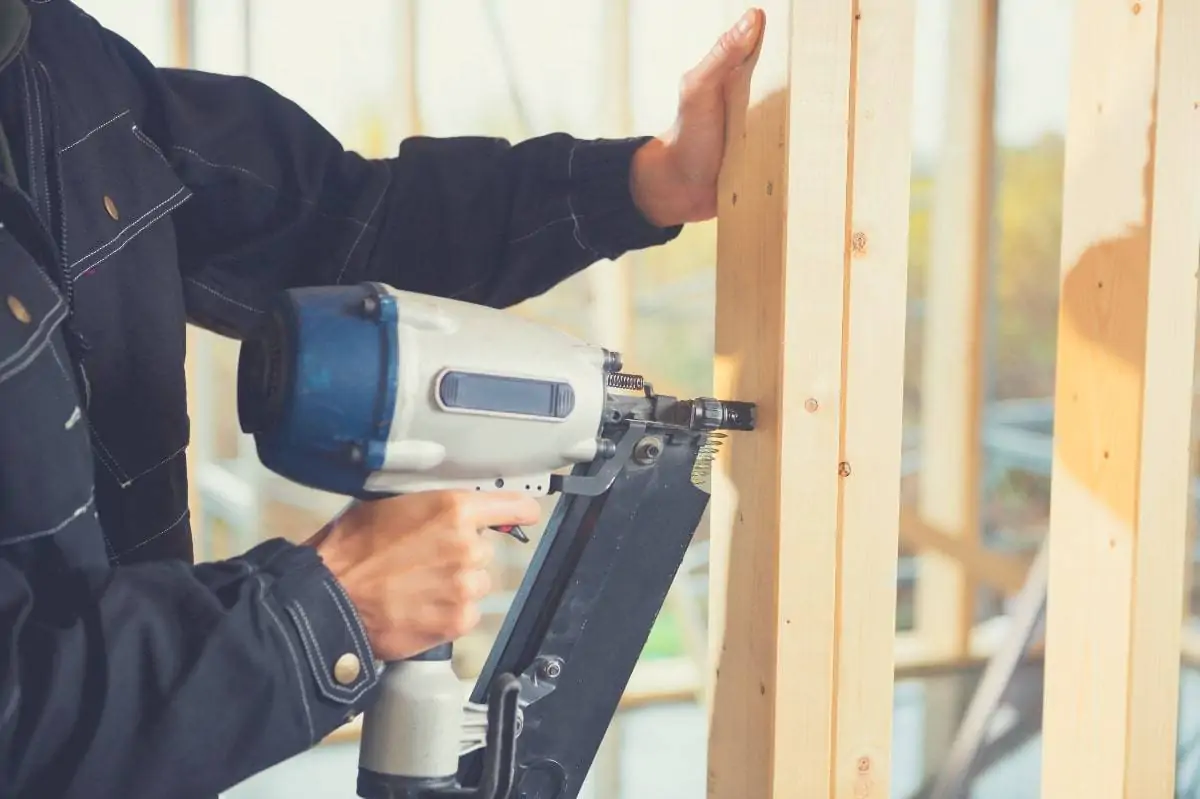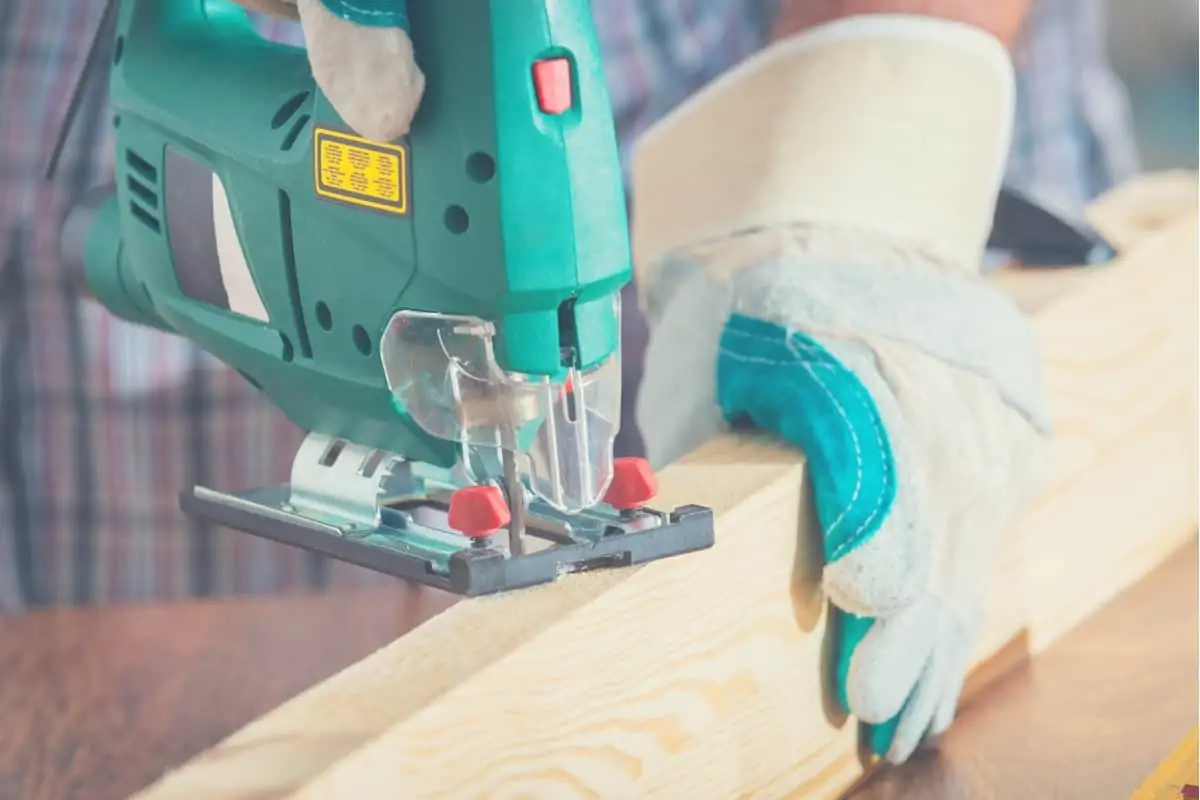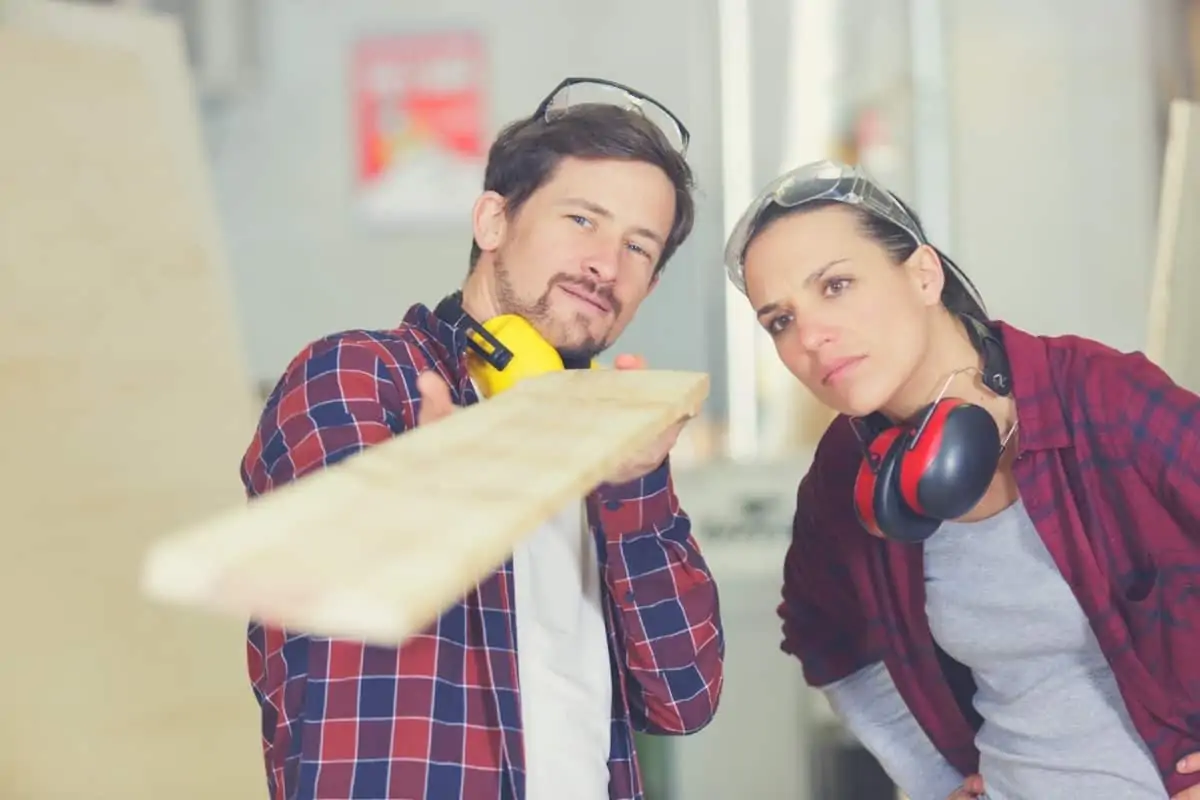MDF and plywood are two of the most common building materials these days, especially for DIY projects. While both have their strengths, they’re not interchangeable. Want to know the difference when you’re comparing MDF vs plywood? Read on and I’ll break down the differences and benefits of the individual materials.
MDF
Medium density fiberboard (MDF) is a homogenous mix of wood fibers and urea formaldehyde resin. It has smooth edges and surfaces, creating the appearance of one solid piece of material.
MDF has a hard surface, making it useful for some structural applications but it’s primarily used indoors due to a lack of moisture resistance. If left totally intreated MDF will soak up water like a sponge and swell, loosing it structural integrity in the process.
MDF covers a range of wood composites, but most of them have roughly the same properties. When choosing your grade you should match it to you intended application. The following are some of the varieties of MDF you’re likely to come across:
- Moisture Resistant MDF- Used in areas like bathrooms where moisture is a constant risk. It can also be used in kitchens. There are some caveats to what you can get away with, which I’ll cover in a moment. These boards are often green.
- Fire Retardant MDF- An MDF variant with higher resistance to flames and heat, but definitely not fireproof. Often used for structural indoor elements such as partition walls where the extra safety is quite welcome. It’s most often red in color.
- Ultra-Light MDF- A newer variant of MDF which is roughly 30% lighter than the standard stuff. It’s great for components that need things like slots or molding but isn’t as suitable for structural applications.
MDF is bound together with urea-formaldehyde based resin. Unfortunately, formaldehyde is a carcinogen and can be irritating to the mouth and nose. The levels generated by cutting or machining MDF aren’t high but you should keep the window open. If that isn’t possible, use a respirator to avoid inhaling massive amounts of sawdust.
Common Uses of MDF
MDF has found a lot of use in the modern world. It’s a go-to material when something small and sturdy needs to be made.
Speaker enclosures, for instance, are often made with MDF before being covered with carpet. It’s also a go-to material for cheap furniture and cabinets. It holds up well over time provided that it’s not exposed to too much moisture.
Furniture is another common use for MDF. If you’ve ever had a low-cost, seemingly wood piece of furniture from somewhere like IKEA then you probably had MDF. It doesn’t have the beauty of natural wood, but it’s often used as a frame in handmade upholstered furniture such as couches.
MDF does take paint well, so it’s still used in tables and other solid pieces of furniture as well. Paint can also form a protective coating, MDF is very vulnerable to moisture unless you’re using a moisture-resistant variety.
Since MDF is naturally fire-resistant it can also be used for architectural components indoors. Providing an extra barrier of protection in case of a flaming emergency. It’s still best to spend the extra on fire-resistant MDF if that’s your end game.
One thing that not many people know: MDF is good for sound-proofing as well. It’s mainly used for smaller indoor applications since drywall is often more cost-effective, but it’s a good use of the material.
There are also a couple of specialty MDF products for specific uses-
- Beadboard- These MDF panels are fastened to look like they have a tongue-and-groove configuration. Beadboard is a decorative element, often used for things like half-wall covers for the striking texture.
- Slatwall- Slatwall is often used in store displays. It comes preconfigured to accept shelving and brackets with the right fastener. Its use around the home is limited but some people use it as a storage solution in garages or kitchens.
MDF’s lack of water resistance is problematic for many uses. Non-moisture-resistant MDF shouldn’t be used in areas with high humidity, as it will soak up water from air without needing to be splashed.
Despite this, MDF is often used to create consumer-grade bathroom and kitchen cabinets. The material is usually coated with a thin wood veneer, keeping water out and providing a more natural look to the cabinets.
Strength, Durability, and Weight of MDF
MDF is quite strong, but it’s not a wonder material in that category. There are some quirks to its strength that shouldn’t be overlooked when planning a project.
One of the biggest things you need to consider: MDF doesn’t like screws. When you screw into MDF you tear apart the fibres and the screw acts like a wedge causing the MDF to split if you’re unlucky.
You can get around this to a degree by drilling a pilot hole that is 85%-90% of the screw’s size. Alternatively, you can join a piece with a trim nailer, which will push the nail through the MDF.
For that reason, you should reinforce most MDF projects with good wood glue, in addition to the fasteners.
MDF is also fairly easy to damage. It will crack under impact or warp under strain more easily than plywood. It’s lower elasticity means that too much loading can warp the board, which won’t return to normal afterward.
MDF is relatively dense, weighing around 49lbs per cubed foot. Keep that in mind if your project requires lifting a large piece of the material.
Barring issues with moisture or physical impact, MDF is a long-lasting material. It’s resistant to termites and dry rot as well, which are two long term threats to any wood.
The big advantage of MDF remains in its uniform consistency. That allows it to be worked in ways that other engineered woods can’t.
Workability of MDF
MDF is a great material to work with, as long as you’re not dealing with nails or screws. The fact is a homogenous solid piece allows it to be machined in a way that other engineered woods can’t.
It’s a good material for decorative use, as long as you aren’t going to miss the natural wood grain. Since it’s so uniform, a router is an excellent way to work with it. The lack of chipping makes it a good choice for objects with tight tolerances. It can even be precision cut with lasers!
The construction of the material means it’s easy to cut. That said, it’s also hard on tools due to the binders and the abrasive properties of wood fibers. High-speed steel isn’t always up to the job. Carbide blades are a good investment if you’ll be working with the material daily.
The key thing here is that MDF doesn’t chip much, allowing it to be worked as a completely solid material. As long as you bear in mind the limitations, like not holding most fasteners well, you can do a lot with MDF.
Cost of MDF
As a general rule, MDF is one of the cheaper engineered composite wood products. The cost can go up with quality, but it remains a low-cost option in many cases.
When compared to solid wood, MDF is always going to be a winner on costs. MDF is generally cheaper than plywood too.
The only common wood which is cheaper than MDF is particle board. But MDF is stronger than particle board and is far more versatile.
Pros and Cons of MDF
Due to its unique construction, MDF is a standout material for many uses. Let’s recap the main pros and cons of MDF.
Pros of MDF
- Cheaper than most composite woods
- Easy to produce good finish
- Takes paint very well
- Better for precision work due to uniformity
- Strong enough to work for cabinets and other minor structural use
- Excellent for painted furniture
Cons of MDF
- Vulnerable to water damage
- Less elasticity than plywood
- Won’t hold up outside
- Doesn’t look like natural wood
- Doesn’t hold fasteners well
MDF is best suited for smaller interior projects, where structural integrity isn’t paramount . It’s also a perfect medium for scrolled designs and other precision work, the lack of chipping allows it to hold together and cut cleanly.
It’s good stuff, but how does it hold up to plywood?
Plywood
Plywood is another popular example of an engineered wood composite. There’s a big difference between it and MDF, both when it comes to it’s its uses, and the construction of the material.
Plywood is made from peeler logs, logs which are cut to produce sheets of veneer. These are then glued together in layers with an adhesive, with a twist.
A literal twist in this case, since plywood has the grain of the wood twisted on each ply. The majority of plywood in the low-to-mid grade range is made with alternating 90-degree angles. Whereas higher grades of plywood often moves in 45-degree increments instead to increase the strength of the board.
The maximum strength of a piece of wood is given by, and in the direction of the grain. So by rotating the direction of the grain, maximum strength in multiple directions can be achieved.
As plywood is made from layers of wood, the surface of a piece of plywood will have the wood grain showing. Higher grades of plywood have better finishes, free from defects and sanded smooth.
It’s also a good material to apply a veneer for decorative purposes. Higher grades of plywood often have very nice finishes, however, it’s not all the C or D grade stuff used in subflooring.
Understanding the grading system will help you get lumber suitable for your own purposes.
Common grades of plywood:
- Grade N- No knots on the surface and sanded smooth. This finish grade is mainly used when someone wants wood grain visible after their finish work.
- Grade A- No visible defects on the surface and sanded smooth. Grade A differs from Grade N plywood in that it’s intended for a painted finish and has a less natural-looking surface.
- Grade B- Smooth but has visible flaws or repairs to the surface veneer in most cases. It may need a little bit of finish work on your part, but it’s not as ragged in appearance as lower grades. Suitable for painting with a little bit of work and the last grade which is considered suitable for being visible.
- Grade C-Rougher than the previous grades, with allowable visible repairs and knots up to 1 ½” in diameter. C-grade plywood is often used in construction, where it will be covered.
- Grade D Plywood- Rough and unfinished, allowable knots up to 2 ½”.
Plywood that you purchase will often have a label like CD. This just indicates that the faces are a different grade from each other, and they’ll be marked for most applications. An X in the designation means moisture resistance.
Common Uses of Plywood
Plywood is used mainly for structure, and it’s a very common construction material. If you’re looking for plywood for a specific application, chances are you can find it. The material is often listed as “indoor plywood” or “marine plywood” or whatever application the wood is intended for.
It’s commonly used for furniture, cabinets, and even walls and roofs. Residential construction uses it extensively for exterior walls for instance.
Plywood is less suitable for projects which require a high level of precision since it’s prone to splintering at the edges. It also tends to require more finish work than you’ll need with MDF. Therefore it’s often used where the wood will be covered or in applications where aesthetics aren’t a big concern.
While it’s not waterproof, plywood can be used for exterior construction in most places. It’s not nearly as vulnerable to moisture as MDF.
Strength, Durability, and Weight of Plywood
As plywood is engineered to maximise strength, with clearly defined grain directs, it’s much stronger than MDF.
As a general rule plywood is better at taking impact than MDF as well. It’s more elastic and has a tendency to come back to the original shape post-impact if nothing breaks.
Plywood is also reasonably durable. While it’s not as good as a solid panel of wood in that respect, it can last for decades when taken care of properly.
Plywood is also less dense than MDF, making it lighter and easier to handle. Combined with the better overall strength of the material it’s easy to see why plywood is used in staircases, floors, and other load bearing applications.
Workability of Plywood
Plywood is one of the basic construction materials, but it’s not suitable for everything.
The edges will always be rough to some extent, but they can be covered with molding or another overlay. The material is great for holding nails and screws in place, which is one of the biggest differences from using MDF.
Plywood can’t be shaped the same way as it tends to splinter along the edges when cut. It’s sometimes used for small projects like toys but it’s not an ideal material for detail. It’s hard to make skinny cuts of the material and the edges are different from the surface.
While not quite as abrasive as MDF, Plywood is still fairly tough on tools. The proportion of adhesive is lower than with MDF, but it still tends to do more damage to blades than real wood. That said, you usually won’t have to invest in carbide blades to regularly cut it if you don’t already have them.
Cost of Plywood
Compared to MDF plywood is more expensive. How much more depends on grade and wood type. Plywood is still less expensive than most real woods, particularly hard woods.
For the most part, plywood costs vary more than MDF due to the wider variety of available grades.
Pros and Cons of Plywood
So, let’s take the above information and break it down for a direct comparison with MDF.
Pros of Plywood
- Works well with standard screws and nails
- Can be used outdoors
- Strong material for its thickness
- Good resistance to impact
- Long-lasting material
- Lighter than MDF
Cons of Plywood
- Splinters at edges, making fine work very hard
- Costs more than MDF
- More variance in board construction
- More finish work required
- Not as suitable for smaller objects
Plywood should generally be viewed as a rough-and-ready construction material. For large projects, especially those exposed to the elements, it should be your go-to wood composite.
MDF vs Plywood, So Which One is Best?
Let’s face it, if there was actually a clear winner in the MDF vs Plywood debate the competitor wouldn’t exist. Both exist to fill their own niches, after all.
In the end, the takeaway is this: MDF is better for detailed projects, furniture, and some internal construction. Plywood is better left for construction work that takes advantage of its increased strength while avoiding finer work that requires a lot of finishing.
Have any questions? Leave a comment below!



